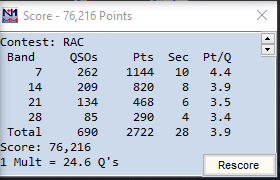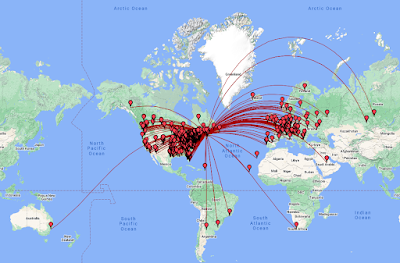Posts Tagged ‘CW’
 Canada Winter contest results
Canada Winter contest results
I am a bit behind with my posting about the Canada Winter contest that happened last weekend. I have been occupied with looking back on 2023 and my New Year's post. As said last weekend was the Canada Winter Contest I took part in the CW-only category and had a blast. The contest covers from 2m to 160m (excluding WARC bands) SSB and CW in which you can do either of both. The conditions were great in this part of the world and the bands were busy with contesters. I called CQ contest (running) for over 90% of the contest which helped me greatly to improve on working pileups.
Some of the contact highlights were contact into the Yukon, South Africa and Australia. My average QSO's per hour was 66 and my highest was 90 per hour. The antenna I was using was the Hustler 4BTV (10m-40m) this limited me from 80 and 160 therefore on Friday evening I had to pull the plug at about 0120 UTC as 40m was closing down for me. The contest finished at 2359UTC on Saturday but I was getting tired and pulled the plug at 2330UTC.
During the day on Friday here in New Brunswick, we did have some freezing rain and that affected some radio ops down this way. Fortunately, I can tilt my antenna over which I did and cleaned the ice off and put it upright again. I did this just before the start of the contest and had no issues.
I loaded my log in ADIF format into Log Analyzer which gave me a map representation of my contacts. You can see my two distant contacts in South Africa and Australia. This software uses the station's grid square for map location. The issue with this is incorrect grid squares give you some odd results. In my case, the map shows one station in Saudi Arabia and another in the middle of the ocean. Both are a result of an incorrect grid square. But overall the program works great and gives you a nice visual of your contest contacts. The Log Analyzer software does have a workaround for when this happens details are found in a link in red at the top of the website page.
 |
| Almost worked all provinces. |
 ARRL 10m contest has come and gone.
ARRL 10m contest has come and gone.
This past weekend was the running of the ARRL 10m contest for both CW and SSB. We are in a very nice time in the solar cycle which makes the 10m contest a popular one. The weekend solar conditions were great with the Kp index floating between Kp0 and Kp1. With good solar weather meaning an active sun also comes solar storms with very high Kp index and poor conditions but this weekend was great. As always here at VE9KK I was CW only entry in the contest. Compared to last year's contest I noticed the window into Europe in the mornings did not last that long this year. I did notice more of a window opened in the afternoon toward South America.
I heard no what might be called exotic DX at my end and most of my scoring was contacting U.S. stations. Due to the propagation of 10m here, I was on the radio at about 7 am local time and off at 5 pm. I found that after 5 pm signals were just not reliable, with many repeats and then the station would just fall off the face of the spectrum. I had a few stations contact me from the Netherlands including Bas PE4BAS a fellow blogger. We did talk a week before the contest about trying to touch base in the contest but you never know.
I have a program called log analyzer in which you load your contest log in ADIF format (other formats are supported). The program gives you a world map of all your contacts, there are many options the program offers. I do find that if a station you contacted in the contest has an incorrect grid square then you may see an odd country you contacted. For me, the contest showed a U.S. station that was in Saudi Arabia. It was due to his incorrect grid square but that only happens very seldom.
In this contest my best 1 hour of running was 100 contacts but most of the time it averaged in around 45-70. I did very little searching and pouncing or S&P as it is called. I enter the contest as unassisted meaning I do not use any spotting software. I do this as it gives me more of a challenge. If I entered the assisted category I would have call signs listed on the waterfall of N1MM+ contest software. I could mouse-click from one call to the next and bang off contacts and points. Also, I could see multipliers as well this way. As for me I have fun unassisted and call CQ contest and S&P the waterfall. Below are the results of this year's ARRL 10m contest. Oh and before I go I did have Murphy visit me during this contest or maybe it was just plain old age. I all of a sudden lost mouse control. No matter what I did there was no movement. I ended up restarting my PC which during a contest is a major deal. Once restarted my old age moment passed and I realized I had mouse control again. It was due to the fact I was using the mouse on the left of my desk before the restart and that is the mouse for my Linux PC!!! On the right side of my desk is my Windows mouse and I did not even realize I was using my left-hand side mouse. No restart was needed in the end after all.
 The Art of DX Pileup Busting
The Art of DX Pileup Busting
SOME INFORMAL THOUGHTS ON WORKING CW DX
Recently, I came across some questions another amateur radio operator posed to a group of CW enthusiasts. Since I have an interest in Morse code, I thought I would explore these questions:
— begin quote —
1. When chasing some particular CW DX station needed for my DXCC punch-list, what are some things(s) that one can do to improve one’s chances of snagging that DX contact amidst a congested pileup? Is it truly the luck of the draw or roll of the dice? Or are there some time tested methods, less than obvious, that the experienced CW DX chasers have used that seem to improve one’s chances of snagging the DX contact? Yes, I’m aware that there are many variables to consider. I’m just looking for some general suggestions to improve my odds of success based on the experience of others.
2. If, let’s say, a DX station appends “UP 1” or “QSX 2” to his CQ call or just “UP” appears in a DX cluster spot listing, what is considered an acceptable amount of “UP”? I’m amazed sometimes at the amount of “UP” that I hear. LOL. Does a hefty amount of “UP” actually improve one’s chances? What does the DX op expect?
3. After a DX station sends their callsign how long should one wait to reply with one’s callsign? I hear stations respond immediately. But sometimes I hear others wait just a “bit”, and then respond to DX. And sometimes when the DX station is responding to a chosen station, other callers are STILL calling the DX op. What do most DX operators expect with regard to the response of a reply? Immediate? One-Mississippi …?
4. I hear stations reply to DX with their callsign once. Others sometimes twice. If I send my callsign twice I run the risk that the DX station has already begun his reply back to me with my sig-report while I’m still in the midst of sending my 2nd callsign reply. So … I should send my call just once?
— end quote–
Great questions! And, the answers translate over to working DX pileups on voice, too.
Here are some of my off-the-cuff remarks, based on my limited experience DXing since 1990:
(I am an avid DXer, with 8BDXCC, etc.)
1. Listen, Listen, Listen: The DX station typically does work split – the DX station on, say, 14.023 MHz, and the DX station is listening anywhere from 14.028 to 14.033 (up 5 to 10). You first, of course, need to listen to the DX station, but, also to hear the stations that are calling the DX station! The trick is to be able to hear some of the stations that are piling up on the DX, and to determine if the DX is working a station, then tunes up a little, or down a little, from the frequency on which the last caller was chosen.
Once you know this, you want to position your signal so that the DX operator tunes to or very near where you are transmitting your signal. If the DX station does not call you but continues in the same tuning direction, you reposition your transmit frequency (always in the pileup window) and try again. If you do not know where the DX station is listening next, and especially if you cannot HEAR the DX station, you are calling blind and are in for a long effort.
If you have a way to see the waterfall at and around the DX frequency, you can often see the general spread of “UP” where the callers congregate. When listening (and, let me tell you, listening is key) to the DX station, watch the waterfall for the responding caller (the station in the pile-up calling the DX), as sometimes it is very obvious who is answering the DX. Watch this exchange for a number of new callers – and get a sense of HOW the DX operator is moving through the pile-up. Anticipate where the DX might listen next. Choose that “next frequency in the pattern of movement” and use that as your calling frequency.
2. Timing your call: this takes a bit of effort. I typically listen to my chosen transmit frequency, trying to call never at the exact same time as others, on or near my calling frequency.
3. I always send my callsign TWICE… something like this:
DX: DX1ABC UP
ME: NW7US NW7US
DX: NW7US 5NN
ME: R R NW7US 5NN TU
DX: NW7US TU, DX1ABC UP
There are some fine CW-oriented DXing books, PDFs, and websites that talk about this. For instance:
http://sota-dl.bplaced.net/articles/cw_chasing_tips_for_newcomers.pdf
https://www.cadxa.org/getting-started-in-dxing.html
I hope this personal observation of mine about working a Morse code pileup is helpful in some way.
73 de NW7US
https://NW7US.us
..
 A bit of a damper
A bit of a damper
I awoke this morning to darkness and rain and according to the weather report, it's going to be all day. Over the past week, I have been having a rainy day of the mind. This happens now and then and it happens to everyone who is in the process of stretching the mind. I got up one day and for the life of me when I was doing my CW practising I was lost when it came to hearing the letters S and H. Which was which....I never had this issue for ever and now I am getting very frustrated as when I hear either of those letters I am at a loss which one it is!! At my speed of 34-36wpm if you have to stop and think you lose everything. With my practice simulator, I would replay a call sign over and over and it was only a guess when I committed to either H or S. This also made the CQ WW CW contest at times very frustrating and at times embarrassing for me.
This has happened in the past and it's nothing new to those who are into Morse code. The word on the street is keep at it and the mind is an amazing thing and it will come around. I am happy to say that as of today for some reason I am back in the zone. I can't explain it but now when I either hear S or H I know exactly which letter it is. Below is one of my practice sessions and the proof is in the picture.
 Space weather Kp6-Kp5 bring it on……….
Space weather Kp6-Kp5 bring it on……….
Due to an active sun which brings us both good and bad conditions today was one of the bad days...or was it. Today I flipped the switch and listened to the bands and what did I find you ask? WI5D (once on 20m and once on40m) as a POTA in a park in Missouri, K3SLH as a POTA in Pennsylvania and LZ600PA as a special event station from Bulgaria. Yes due to the space weather, it was a slow day on the bands. On 15m and 20m one had to watch the waterfall as signals would just pop out and then soon after gone again. The way I look at it any day on the radio is a good day. It was not all glory on the bands I did have some POTA stations lost in the mud after my call out to them.
 VE9KK the world of CW 2023-11-27 18:05:00
VE9KK the world of CW 2023-11-27 18:05:00
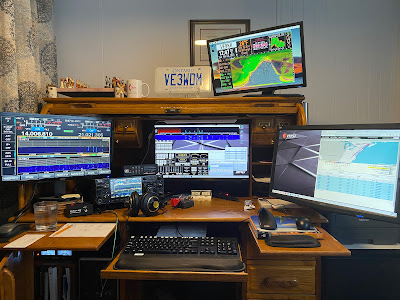 |
| My setup and the VE3WDM is my lic plate from Ontario |
This past weekend I was busy with the CQ World Wide CW contest...go figure! The solar weather was not looking good and for most of Saturday, the Kp index was around 6 and for a short time moved to 7. I was shocked the conditions were still decent. On Sunday the Kp index fell to 2-3 which also gave better conditions. I entered as low power (100 watts), all band and unassisted meaning I did not use QSO finding assistance. The bands I operated were limited to my antenna the Hustler 4BTV which meant that was 40,20,15 and 10m.
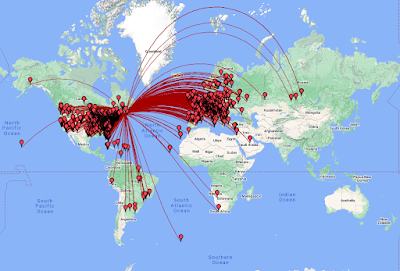 |
| Spot in the middle of the Ocean is code garble SN70 I put zero and not the letter O |
Some of my highlights were getting a call from fellow blogger Bas PE4BAS, KH7L and V51YJ. I think because of the conditions solar weather wise it limited me from Southeast Asia. I did spend a lot of time in the operating chair and toward the end of the contest I started to get what I call "code garble". I heard a call but it just did not register, I heard a call but entered numbers or letters on the keyboard that had nothing to do with the call and so on. For example, numerous time I had a call starting 9A call me and every time I entered 0A. I kept having to correct it and that meant time and good old 9A wondered what I was up too. I ended up pulling the plug about an hour before the contest ended.
My best hourly contact rates were in the 130's and at the low-end 50's. I have been practising handling pileups using N1MM logger. You can set it up to give you pileup simulations. Not that I am a big gun but when you get spotted on the cluster things can get a bit hairy at times.
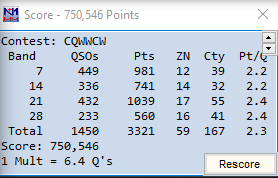 |
| The final results |
During the contest 99% of the time I was calling "CQ contest" or running as it is called. My speed was 32-34 wpm. I find if your calling at 32 wpm you get replies at 25-36 wpm. When calling at 34wpm sometimes the comebacks can be very fast and mistakes happen. In this contest, the exchange is 599 (signal report) and CQ zone and that is filled in by the contest program. This means when your calling CQ contest you can go a bit faster as most slower callers most likely found your call on the cluster. When a serial number is involved a lot of contest stations slow down the serial number part of the exchange.
Overall it was a great contest and I look forward to it again next year. The next contest I am looking at is the RAC Canadian Winter contest in December.
 Chances like this only come now and then……….
Chances like this only come now and then……….
 |
| The bands will come alive |
This weekend is the running of the CQ World Wide DX CW contest that runs for the entire weekend. Now those of you who are not into contesting then it's off the SSB portion, digi portion or the WARC band. But you don't have to be a contesting nut like me to be excited about this contest. This is a chance to find and make contact with some very decent DX. It will give you a chance to line your DXCC pockets, work all states award, work all zones award, place your rig in QRP or QRPp power and see how many miles per watt you can do and the list goes on. Not too great at CW you say, well there are some very decent code reader software out there that also send code as well. Chances like this only come now and then.
As for me I am going to be for the weekend and hope to do well and have a lot of fun while I am at it. Cheers and have a good weekend for those in the U.S. Happy Thanksgiving!
